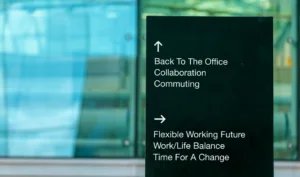
What Hybrid Worker Preferences Reveal About the Future of Work
We don’t need research to tell us the future of work will be much different from pre-pandemic norms. But Covid isn’t the cause. Disruption was

We don’t need research to tell us the future of work will be much different from pre-pandemic norms. But Covid isn’t the cause. Disruption was

When you think about your future within your organization, what do you envision? Do you anticipate moving up through the ranks into a managerial or

As 2022 comes to a close, several work trends are clearly visible on the horizon. Here’s one employers can’t afford to ignore — an alarming

As 2022 draws to a close, most organizations are deeply involved in planning, budgeting and forecasting for the coming year. To complete this rigorous process,

I’m a fan of fun work environments. So of course, I’m also a fan of humor at work. Don’t get me wrong. I’m not saying

Have you noticed that workforce engagement and motivation are slipping? You’re not the only one. In April, Gallup confirmed that U.S. workforce engagement declined from

In 2020, our most popular blog post discussed how leaders could move forward when Covid abruptly forced many of us to work from home. I

Employee appreciation is naturally top-of-mind for employers during the holiday season. But employees actually prefer recognition throughout the year. In fact, according to a HubSpot

As social beings, many of our relationships are based on reciprocity. At work, we’re often involved in transactional behavior, where we expect to receive at

Some conversations stay with me. It could be something about the subject, the wisdom of the person I’m talking to, or the timeliness of the

EDITOR’S NOTE: This is the last article in a 4-part series sponsored by Unit4. The series outlines a new approach to talent strategy for people-centric

When someone says it’s time for performance evaluations, what happens? You can almost hear a collective groan ripple across an organization. Reactions run the gamut,

Friendships are an essential aspect of work life. But friendships among remote employees aren’t the same as relationships among people who spend time together in

Sponsored by: Ivanti You’ve heard the adage “measure twice, cut once.” It’s good advice from the sewing world. The idea is to encourage people who

The working world has spoken: Employees want to be part of organizations that value and support diversity, equity and inclusion (DEI). But they won’t accept

Sponsored by: ThoughtExchange For several months, we’ve been sharing insights from our partner ThoughtExchange. They’ve done some fascinating research on Gen Z employees, employee experience,

Leaders and managers frequently refer to the famous Albert Einstein quote when something in their organizations isn’t working after repeated efforts. I wonder what Einstein

When it comes to the workplace, happiness is key. Studies have shown that happy employees are more productive and efficient. That’s why employers need to

Sometimes research emerges that sets a new high-water mark on a troubling trend — and it’s well worth paying attention to. That’s the case with

Investment in learning and talent development is an essential ingredient of every company’s engagement and retention plans. What is one crucial topic to include in

One of the important factors involved in running a business is finding and retaining good employees. Yet, employees choosing to leave a job due to

The Great Resignation has highlighted the importance of employee retention, but do you know which employees you need to engage the most? What should managers

We bought mental health tools, but has everyone bought in? Many companies understand the importance of promoting mental health in the workplace. As a result,

Many business experts champion trust in the workplace. They include the likes of Stephen Covey and my dear friend, David Horsager. (His 8 Pillars of

What is your leadership DNA? It is your authentic self. The concept of authentic leadership is often bantered about. In my experience of working with leaders